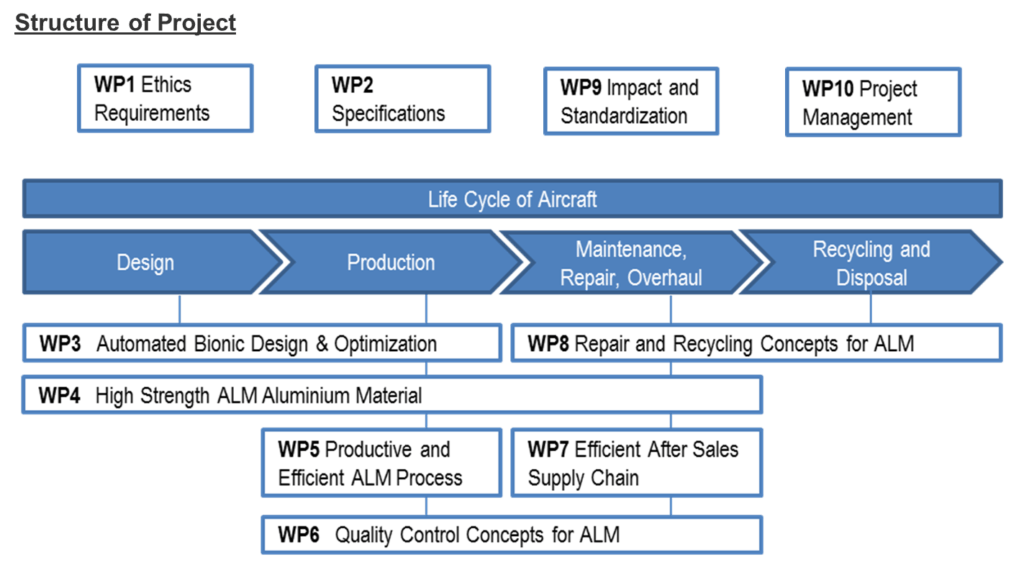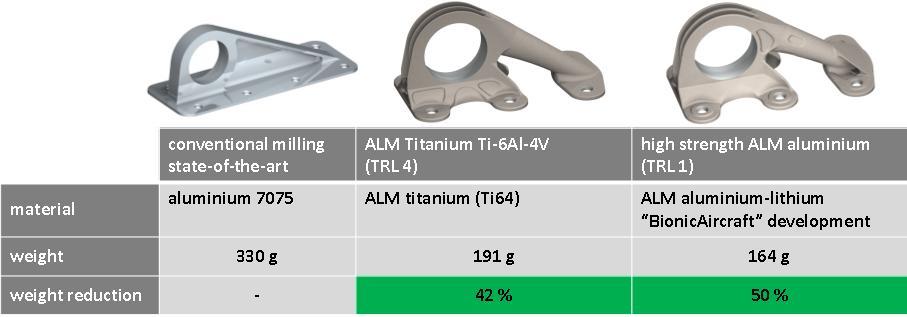Bionic Aircraft Collaborative Research Project Works to Increase the Efficiency of Aviation Resources through Additive Manufacturing
 3D printing and 3D scanning technologies have been making major headway into aviation recently, and these uses are only set to expand. We have seen 3D printed airplanes before, used in the military, and also with some pretty cool unmanned aircraft. There are 3D printed airplane components, 3D scanning has been used to recreate historic metal aircraft, and the technology has even been used to streamline the aircraft certification standards process with 3D printed artificial “ice.” But here’s a new one: IT specialist CENIT, along with nine other international partners, is taking part in a European research project called Bionic Aircraft.
3D printing and 3D scanning technologies have been making major headway into aviation recently, and these uses are only set to expand. We have seen 3D printed airplanes before, used in the military, and also with some pretty cool unmanned aircraft. There are 3D printed airplane components, 3D scanning has been used to recreate historic metal aircraft, and the technology has even been used to streamline the aircraft certification standards process with 3D printed artificial “ice.” But here’s a new one: IT specialist CENIT, along with nine other international partners, is taking part in a European research project called Bionic Aircraft.
 The project’s goal is to increase the efficiency of aviation resources by adding bionic design and additive manufacturing to all parts of the lifecycle of an aircraft. After a recent concept review, CENIT has begun its part of the project, by implementing its software toolset for automated bionic design. The collaborative research project launched in September of 2016 and is co-funded by the European Commission’s Horizon 2020 program, which has additionally funded other 3D printing research projects.
The project’s goal is to increase the efficiency of aviation resources by adding bionic design and additive manufacturing to all parts of the lifecycle of an aircraft. After a recent concept review, CENIT has begun its part of the project, by implementing its software toolset for automated bionic design. The collaborative research project launched in September of 2016 and is co-funded by the European Commission’s Horizon 2020 program, which has additionally funded other 3D printing research projects.
 A total of ten international consortium partners, from different R&D organization and industry sectors, are working on the project together to develop additive manufacturing concepts and technologies that will “enable environment-friendly end2end lifecycles in the aviation industry.” The real aim is to control, and ultimately reduce, emissions in the overall industry of aviation. If additive manufacturing can be successfully introduced in all phases of the lifecycle of the aircraft, we are looking at the possibility of ultra-light planes, resource-efficient supply chains, flexible production of complex aircraft components, and optimized concepts for spare part logistics, aircraft repair, and recycling. Additive manufacturing can also produce lighter-weight components, which is always a key consideration in aircraft manufacture, as well as reduce waste generated in the production process as compared to traditional subtractive techniques.
A total of ten international consortium partners, from different R&D organization and industry sectors, are working on the project together to develop additive manufacturing concepts and technologies that will “enable environment-friendly end2end lifecycles in the aviation industry.” The real aim is to control, and ultimately reduce, emissions in the overall industry of aviation. If additive manufacturing can be successfully introduced in all phases of the lifecycle of the aircraft, we are looking at the possibility of ultra-light planes, resource-efficient supply chains, flexible production of complex aircraft components, and optimized concepts for spare part logistics, aircraft repair, and recycling. Additive manufacturing can also produce lighter-weight components, which is always a key consideration in aircraft manufacture, as well as reduce waste generated in the production process as compared to traditional subtractive techniques.
 To achieve the project goals, a total of ten work packages were defined, addressing aspects like production, design, quality control, materials development, repair, and disposal of additively manufactured components. For its project task field, CENIT is collaborating specifically with Airbus, Laser Zentrum Nord GmbH (LZN), and the Institute for Laser and System Technologies (iLAS) at TU-Hamburg-Harburg, to “achieve a significant simplification of product development for lightweight bionic structures using streamlined design methodologies,” which is one of the biggest potentials, and challenges, when it comes to additively manufacturing aircraft: components that are unable to be manufactured through traditional methods of production.
To achieve the project goals, a total of ten work packages were defined, addressing aspects like production, design, quality control, materials development, repair, and disposal of additively manufactured components. For its project task field, CENIT is collaborating specifically with Airbus, Laser Zentrum Nord GmbH (LZN), and the Institute for Laser and System Technologies (iLAS) at TU-Hamburg-Harburg, to “achieve a significant simplification of product development for lightweight bionic structures using streamlined design methodologies,” which is one of the biggest potentials, and challenges, when it comes to additively manufacturing aircraft: components that are unable to be manufactured through traditional methods of production.
Michael Schwartz, Manager for Innovative Aerospace Solutions at CENIT, explains, “One of the main reasons why additive manufacturing and 3D printing has not yet had a major impact on aircraft manufacturing is the elaborate design process. Since this is not yet automated, it must be carried out via a series of different software packages. Specialized software is also needed to process data for the 3D printing machines. During the design phase, the engineers thus have to switch back and forth between different tools. This makes the process time-intensive, and that in turn makes it expensive. CENIT’s work thus focuses on a major simplification of the design process. To achieve this, we are integrating all 3D print, design and data conditioning processes into a single toolset for automated bionic design. That way, we can help establish a consistent digital process chain.”
 CENIT, Airbus, LZN, and iLAS are working on the the development of a 3D-CAD toolset for the use of CATIA in bionic design, establishing additive manufacturing design guidelines, and 3D print data conditioning, including bionically optimized structures. Airbus has made some headway in inexpensive and efficient spare part production, by introducing additively manufactured plastic parts. According to the Bionic Aircraft Project Objectives page, the company predicts “a weight reduction of over 1 ton per aircraft in the short term through the introduction of AM.” The company will work on developing additive manufacturing of aluminium next. Additionally, studies of bionic lightweight structures in titanium are showing “up to 40% weight reduction with production waste smaller than 10% of the initial material,” and by adding high-strength aluminium alloys, the potential exists for even more weight saving.
CENIT, Airbus, LZN, and iLAS are working on the the development of a 3D-CAD toolset for the use of CATIA in bionic design, establishing additive manufacturing design guidelines, and 3D print data conditioning, including bionically optimized structures. Airbus has made some headway in inexpensive and efficient spare part production, by introducing additively manufactured plastic parts. According to the Bionic Aircraft Project Objectives page, the company predicts “a weight reduction of over 1 ton per aircraft in the short term through the introduction of AM.” The company will work on developing additive manufacturing of aluminium next. Additionally, studies of bionic lightweight structures in titanium are showing “up to 40% weight reduction with production waste smaller than 10% of the initial material,” and by adding high-strength aluminium alloys, the potential exists for even more weight saving.
This research project is significant for CENIT, both as an enterprise and in terms of the entire aviation industry. The results of this three-year project are expected to be groundbreaking.
“3D printing technologies and bionic structures are a major enabler in creating competitive, environment-friendly aircraft for the future. We are proud that we can contribute to such an ambitious, cutting-edge project,” said Schwartz. “Among other goals, we aim to achieve a reduction in overall development times for optimized 3D print components, as well as major weight-saving potentials for aircraft. These will lead to significant reductions in CO2 emissions throughout the entire service life of the aircraft.”
Besides the stated project goals, the consortium expects to uncover a range of additional results at the end of the project. Discuss in the BionicAircraft forum at 3DPB.com.
[Source: CENIT / Images: Bionic Aircraft Project]Subscribe to Our Email Newsletter
Stay up-to-date on all the latest news from the 3D printing industry and receive information and offers from third party vendors.
Print Services
Upload your 3D Models and get them printed quickly and efficiently.
You May Also Like
Nikon SLM Solutions Sells SLM 500 to Primary Weapon Systems to Expand Suppressor Production
Primary Weapons Systems (PWS) is a Boise, Idaho-based manufacturer of suppressors, firearms, and related components. A subsidiary of Vigilant Gear and a sister company to aftermarket Glock slide manufacturer Lone...
3DPOD 261: Tooling and Cooling for AM with Jason Murphy, NXC MFG
Jason Murphy´s NXC MFG (Next Chapter Manufacturing) is not a generalist service; instead, the company specializes in making tooling. Using LPBF and binder jet, the company produces some of the...
HP and Firestorm Labs Form Partnership to Use Multi Jet Fusion 3D Printers in Deployable Factories
HP Inc., maker of a range of additive manufacturing (AM) solutions including the Multi Jet Fusion (MJF) ecosystem, has announced a partnership with Firestorm Labs, a developer of containerized, deployable...
3D Printing News Briefs, July 2, 2025: Copper Alloys, Defense Manufacturing, & More
We’re starting off with metals in today’s 3D Printing News Briefs, as Farsoon has unveiled a large-scale AM solution for copper alloys, and Meltio used its wire-laser metal solution to...

































